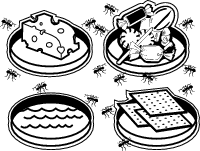Science Projects for Beginners: What Foods Attract Ants?
What Foods Attract Ants?
Did you ever wonder why ants seem to have a one-track mind for sweets? Leave a cookie on the counter in a kitchen that has become residence to some ants, and it's guaranteed that they'll find it—quickly.
So what is it with ants and their collective sweet tooth? Do ants even have teeth? No, they don't have teeth. They do, however, have a chemical sensory aid that directs them to the foods they love the most. It would be like you having a built-in radar device that beeps whenever you get within 50 yards of an ice cream shop.
In this science fair project, you try to determine which foods from your kitchen ants like best. The experiment is not conducted inside the kitchen (much to Mom's relief), but outside in a corner of your yard or other area in which you can work.
Scientific Surprise
Ants are pretty amazing little creatures. They can lift 20 times their own body weight. If a man could run at a comparable speed with an ant, he could run as fast as a racehorse. Alas, however, the average life expectancy of an ant is only 45 to 60 days.
To learn about the eating habits of ants, you can place several types of food in separate, flat container lids. Using a permanent marker, write on each lid the type of food it will hold. Be sure to include these three different types of foods:
- Sweets, such as candy, brown sugar, or fruit juice
- Proteins, such as meat, cheese, or milk
- Carbohydrates, such as crackers, or cooked rice or pasta
Every day for a week, place a small amount of various types of food in a shallow lid. You can use just one food from each group or more than one—it's up to you. Just be sure to include at least one of each type of food. And remember to put about the same amount of food in each lid. Group all the lids together in a small area accessible to ants.

Also, set out a lid containing plain water. That will serve as your control. The foods are the variables.
Once you've placed the food in the lids outside, you'll need to watch it pretty carefully. You'll want to take a look every couple of hours to see what's going on.
Take a notebook with you and record what you see—don't count on remembering later on. Try to establish patterns by watching which foods attract the most ants, and which foods the least. How long does it take for ants to find the food? How long do the same ants hang out at the outdoor caf you've provided for them? Do more ants appear once the food site has been established for several days?
When you've observed the behavior and habits of the ants over an entire week, you can chart your observations.

Excerpted from The Complete Idiot's Guide to Science Fair Projects © 2003 by Nancy K. O'Leary and Susan Shelly. All rights reserved including the right of reproduction in whole or in part in any form. Used by arrangement with Alpha Books, a member of Penguin Group (USA) Inc.
To order this book direct from the publisher, visit the Penguin USA website or call 1-800-253-6476. You can also purchase this book at Amazon.com and Barnes & Noble.
